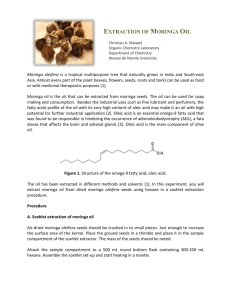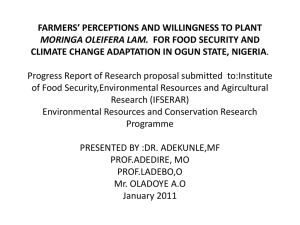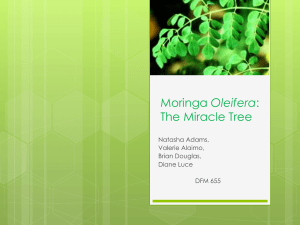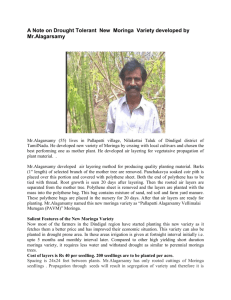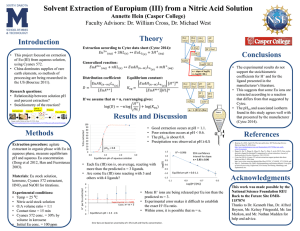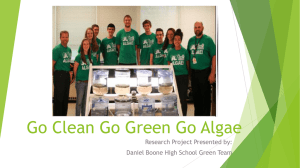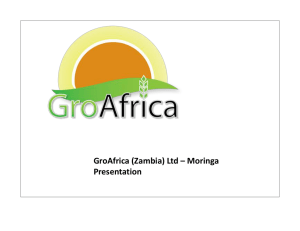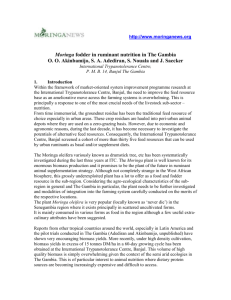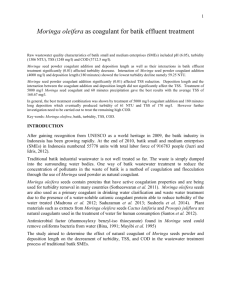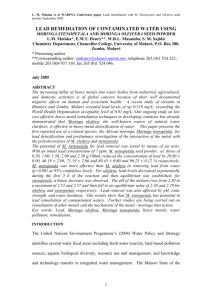Extraction and characterization of oil from Moringa
advertisement
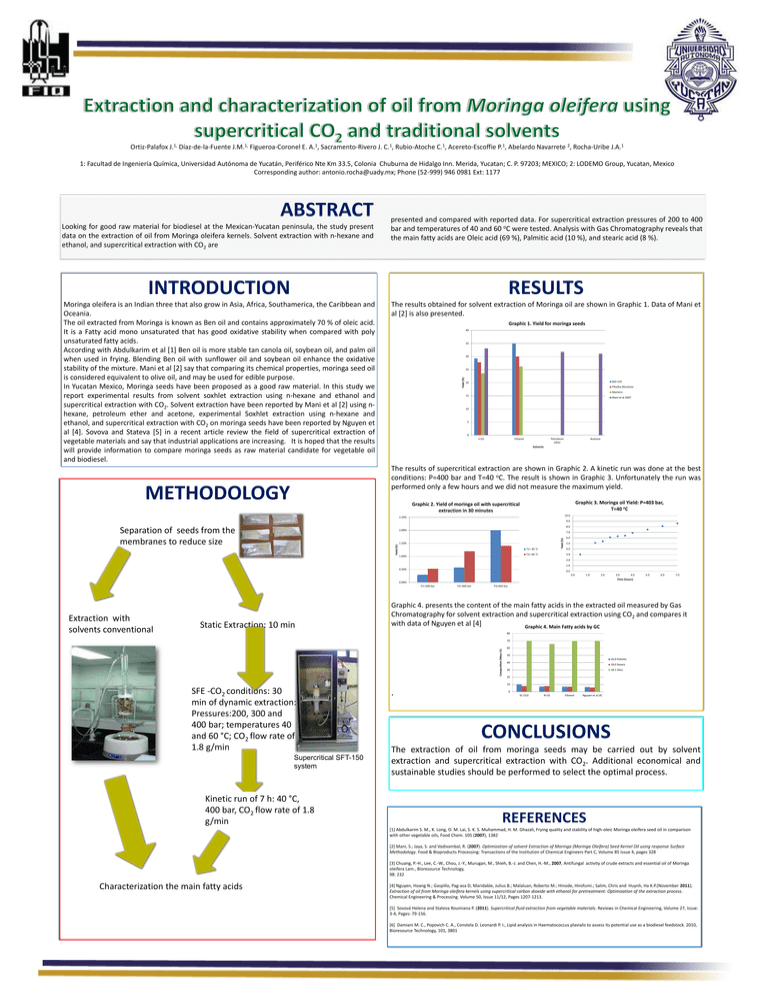
Ortiz-Palafox J.1, Díaz-de-la-Fuente J.M.1, Figueroa-Coronel E. A.1, Sacramento-Rivero J. C.1, Rubio-Atoche C.1, Acereto-Escoffie P.1, Abelardo Navarrete 2, Rocha-Uribe J.A.1 1: Facultad de Ingeniería Química, Universidad Autónoma de Yucatán, Periférico Nte Km 33.5, Colonia Chuburna de Hidalgo Inn. Merida, Yucatan; C. P. 97203; MEXICO; 2: LODEMO Group, Yucatan, Mexico Corresponding author: antonio.rocha@uady.mx; Phone (52-999) 946 0981 Ext: 1177 ABSTRACT Looking for good raw material for biodiesel at the Mexican-Yucatan peninsula, the study present data on the extraction of oil from Moringa oleifera kernels. Solvent extraction with n-hexane and ethanol, and supercritical extraction with CO2 are presented and compared with reported data. For supercritical extraction pressures of 200 to 400 bar and temperatures of 40 and 60 oC were tested. Analysis with Gas Chromatography reveals that the main fatty acids are Oleic acid (69 %), Palmitic acid (10 %), and stearic acid (8 %). INTRODUCTION RESULTS Moringa oleifera is an Indian three that also grow in Asia, Africa, Southamerica, the Caribbean and Oceania. The oil extracted from Moringa is known as Ben oil and contains approximately 70 % of oleic acid. It is a Fatty acid mono unsaturated that has good oxidative stability when compared with poly unsaturated fatty acids. According with Abdulkarim et al [1] Ben oil is more stable tan canola oil, soybean oil, and palm oil when used in frying. Blending Ben oil with sunflower oil and soybean oil enhance the oxidative stability of the mixture. Mani et al [2] say that comparing its chemical properties, moringa seed oil is considered equivalent to olive oil, and may be used for edible purpose. In Yucatan Mexico, Moringa seeds have been proposed as a good raw material. In this study we report experimental results from solvent soxhlet extraction using n-hexane and ethanol and supercritical extraction with CO2. Solvent extraction have been reported by Mani et al [2] using nhexane, petroleum ether and acetone, experimental Soxhlet extraction using n-hexane and ethanol, and supercritical extraction with CO2 on moringa seeds have been reported by Nguyen et al [4]. Sovova and Stateva [5] in a recent article review the field of supercritical extraction of vegetable materials and say that industrial applications are increasing. It is hoped that the results will provide information to compare moringa seeds as raw material candidate for vegetable oil and biodiesel. The results obtained for solvent extraction of Moringa oil are shown in Graphic 1. Data of Mani et al [2] is also presented. Graphic 1. Yield for moringa seeds 40 35 30 Yield (%) 25 Ball mill 20 Pikalika Moulinex Mortero 15 Mani et al 2007 10 5 0 n-C6 Ethanol Petroleum ether Acetone Solvente The results of supercritical extraction are shown in Graphic 2. A kinetic run was done at the best conditions: P=400 bar and T=40 oC. The result is shown in Graphic 3. Unfortunately the run was performed only a few hours and we did not measure the maximum yield. METHODOLOGY Graphic 3. Moringa oil Yield: P=403 bar, T=40 oC Graphic 2. Yield of moringa oil with supercritical extraction in 30 minutes 10.0 2.50% 9.0 8.0 Separation of seeds from the membranes to reduce size 7.0 Yield (%) Yield (%) 2.00% 1.50% T1= 40 °C T2= 60 °C 1.00% 6.0 5.0 4.0 3.0 2.0 1.0 0.50% 0.0 0.0 1.0 2.0 3.0 4.0 5.0 6.0 7.0 Time (hours) 0.00% P1=200 bar Extraction with solvents conventional Static Extraction: 10 min P2=300 bar P3=403 bar Graphic 4. presents the content of the main fatty acids in the extracted oil measured by Gas Chromatography for solvent extraction and supercritical extraction using CO2 and compares it with data of Nguyen et al [4] Graphic 4. Main Fatty acids by GC 80 Composition (Mass %) 70 60 50 16:0 Palmitic 40 18:0 Stearic 30 18:1 Oleic 20 10 SFE -CO2 conditions: 30 min of dynamic extraction: Pressures:200, 300 and 400 bar; temperatures 40 and 60 °C; CO2 flow rate of 1.8 g/min Supercritical SFT-150 system Kinetic run of 7 h: 40 °C, 400 bar, CO2 flow rate of 1.8 g/min . 0 SC-CO2 N-C6 Ethanol Nguyen et al [4] CONCLUSIONS The extraction of oil from moringa seeds may be carried out by solvent extraction and supercritical extraction with CO2. Additional economical and sustainable studies should be performed to select the optimal process. REFERENCES [1] Abdulkarim S. M., K. Long, O. M. Lai, S. K. S. Muhammad, H. M. Ghazali, Frying quality and stability of high-oleic Moringa oleifera seed oil in comparison with other vegetable oils, Food Chem. 105 (2007), 1382 [2] Mani, S.; Jaya, S. and Vadivambal, R. (2007). Optimization of solvent Extraction of Moringa (Moringa Oleifera) Seed Kernel Oil using response Surface Methodology. Food & Bioproducts Processing: Transactions of the Institution of Chemical Engineers Part C, Volume 85 Issue 4, pages 328 [3] Chuang, P.-H., Lee, C.-W., Chou, J.-Y., Murugan, M., Shieh, B.-J. and Chen, H.-M., 2007, Antifungal activity of crude extracts and essential oil of Moringa oleifera Lam., Bioresource Technology, 98: 232 Characterization the main fatty acids [4] Nguyen, Hoang N.; Gaspillo, Pag-asa D; Maridable, Julius B.; Malaluan, Roberto M.; Hinode, Hirofumi.; Salim, Chris and Huynh, Ha K.P.(November 2011); Extraction of oil from Moringa oleifera kernels using supercritical carbon dioxide with ethanol for pretreatment: Optimization of the extraction process. Chemical Engineering & Processing. Volume 50, Issue 11/12, Pages 1207-1213. [5] Sovová Helena and Stateva Roumiana P. (2011). Supercritical fluid extraction from vegetable materials. Reviews in Chemical Engineering, Volume 27, Issue: 3-4, Pages: 79-156. [6] Damiani M. C., Popovich C. A., Constela D. Leonardi P. I., Lipid analysis in Haematococcus plavialis to assess its potential use as a biodiesel feedstock. 2010, Bioresource Technology, 101, 3801
